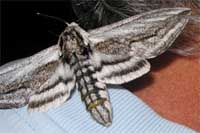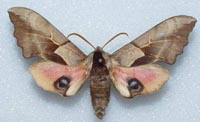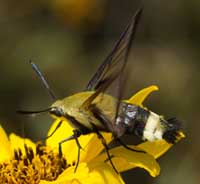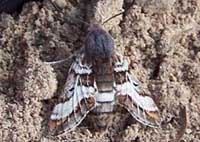Sphinginae subfamily
Sphingini tribe:
 |
This moth is a very strong flier, and make its way to
southern Arizona and southern California.
|
 |
I suspect if you grow tomatoes, you are likely to encounter it.
|
 |
The abdomen of the adult moth has three pairs of yellow spots. The upperside of the forewing is yellowish brown to deep chocolate brown with a dusting of white
scales and zigzagged black and white lines.
|
 |
Manduca sexta
WO, the Carolina Sphinx.
The abdomen usually has six pairs of yellow bands, broken across the back. The sixth set of markings is quite small.
The upperside of the forewing has indistinct black, brown, and white markings.
If you grow tomatoes, you have probably encountered it, though.
Larvae get very large and can strip a tomato plant.
|
 |
The upperside of the forewing has a wide white band along the costa
from base to apex. The remainder of the wing has black and white
bands.
|
 |
Sphinx chersis
WO,
the Northern Ash Sphinx or Great Ash Sphinx
This species is reported in Pima. Larval hosts are ash,
lilac, privet, cherry, and quaking aspen.
|
Smerinthini Tribe:
 |
This one is quite similar to Pachysphinx modesta, with modesta
being smaller and darker.
Moths should be on the wing from June-August.
|
 |
Paonias myops
BAMONA, the Small-eyed Sphinx
Named for the small eye-spot in the hindwing, this moth has a wide
distribution.
|
 |
Smerinthus cerisyi
WO, the Cerisyi's
Sphinx or One-eyed Sphinx, Larvae feed on poplars and willows.
Flight would be from late May-July as a single brood.
|
 |
Smerinthus saliceti
WO, the Salicet
Sphinx, flies in valleys and along streamsides from Mexico City north
to west Texas, southern Arizona, and extreme southern California.
Larvae feed on poplars and willows.
Flight would be from late April-September, probably as a double brood.
|
Macroglossinae subfamily
Dilophonotini tribe:
 |
This species is reported in Pima County and in other southern
Arizona counties.
Males and females differ. rare
|
 |
During the night adults nectar at flowers, including bouncing bet
(Saponaria officinalis) and Asystasia gangetica beginning at dusk.
July and August are flight times in the southern states.
|
 |
Hemaris thetis
WO,
the Thetis Clearwing or Bee Hawk Moth,
The moth flies along forest edges and in meadows, gardens and
brushy fields. Day-flying adults nectar at lantana, dwarf bush honeysuckle,
snowberry, orange hawkweed, thistles, lilac, Canada violet, etc.
|
Philampelini tribe:
 |
This moth is officially reported for Pima County.
Eumorpha achemon larvae feed upon Grape (Vitis),
Virginia Creeper (Parthenocissus quinquefolia)
and other vines and ivies (Ampelopsis).
|
Macroglossini tribe:
 |
Adults nectar at flowers during the warm parts of the day.
Euproserpinus phaeton adults fly swiftly and close to the ground over
dry washes and flat areas in deserts as a single brood from
February-April.
|
 |
Hyles lineata
WO,
the White-lined Sphinx
Adam Fleishman reports many August 11-21 in Tucson, Arizona.
David Bygott sent a larva image in April.
Larvae can be quite varied.
|
|
|
